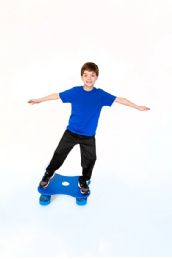

















What Causes Balance Problems?
Dizziness, vertigo and disequilibrium are common symptoms that can result from a peripheral vestibular disorder or a central vestibular disorder. A peripheral vestibular disorder is a dysfunction of the balance organs of the inner ear. A central vestibular disorder is a dysfunction of one or more parts of the central nervous system that helps process balance and spatial information. Although the three symptoms can be linked by a common cause, they all have different meanings. Describing them accurately to a doctor can mean the difference between a successful diagnosis and one that is missed. Dizziness is a sensation of lightheadedness, faintness, or unsteadiness. Vertigo has a rotational, spinning component and is the perception of movement, either of the individual or the surrounding objects. Disequilibrium simply means imbalance, unsteadiness, or loss of equilibrium that occurs with spatial disorientation.
What Causes Vestibular Disorders?
The vestibular system includes the brain and parts of the inner ear that process the sensory information involved with controlling eye movements and balance. If injury or disease damages these processing areas, vestibular disorders can result. These disorders can also come from, or be worsened by environmental or genetic conditions, or happen for unknown reasons. The most commonly diagnosed vestibular disorders include labyrinthitis or vestibular neuritis, benign paroxysmal positional vertigo (BPPV), Meniere’s disease, and secondary endolymphatic hydrops. Vestibular disorders also comprise acoustic neuroma, superior semicircular canal dehiscence, perilymph fistula, enlarged vestibular aqueduct, ototoxicity, migraine-associated vertigo, and mal de debarquement. Other problems related to vestibular dysfunction include complications from autoimmune disorders, aging and allergies.
What is Vestibular Therapy?
Vestibular therapy, also referred to as vestibular rehabilitation therapy (VRT), is a noninvasive, specialized treatment designed to help individuals overcome chronic vertigo and dizziness caused by inner ear disorders. The therapy consists of various exercises designed to improve ocular motor skills, visual orientation, gait, and balance. The therapy is normally performed by a physical or occupational therapist and consists of routines to be performed at a rehab facility as well as at home. Certain individuals experience chronic bouts of vertigo and dizziness because of certain types of inner ear disorders. The sensations of tilting or spinning often cause a person to be off balance and to lack the coordination needed to perform everyday activities, such as walking. These conditions can negatively affect a person’s quality of life and be debilitating. Often doctors recommend this type of therapy as a way to cope with, and eventually overcome, the vertigo and dizziness.
The purpose of vestibular therapy is to retrain the brain so the incorrect signals that are generated by the inner ear are reinterpreted and corrected. Generally, either physical or occupational therapists guide their patients through a series of supervised exercises intended to gradually reduce the symptoms of vertigo and dizziness. These exercises are designed to force the brain to make up for the misinformation. To accomplish this, a therapist focuses on two main areas, namely body positioning and visual perception. Regarding visual aspects, patients perform certain exercises to reinforce visual perception of stationary objects. They also engage in routines designed to improve object tracking and eye movement. These activities are performed on a regular basis both at the rehab facility and at home. They help the brain to compensate for, and eventually override, the incorrect input coming from the balance centers in the inner ear. Instead, the brain learns to depend on the information that is generated through visual perception.
The second aspect of vestibular therapy focuses on helping patients regain a sense of balance and normal movement, and on body positioning. When individuals experience the sensation of motion as with vertigo, they compensate by changing their stance and gait. For example, many develop a habit of swaying side to side when walking in order to stay balanced, much the same way as a person walking on a subway train, or a boat. This response strengthens the brain’s interpretation of the signals created by the inner ear, basically validating the perception of motion. By slowly reinforcing a sense of balance and correcting a person’s gait, therapists hope to correct the brain’s misinterpretation of motion.
Once the patients have begun to adjust visual perception with regard to the therapy, they perform exercises designed to help restore a sense of balance while standing still. Due to the fact that some individuals have changed the way they walk to compensate for the sense of motion, they must relearn the correct way to walk using a heel-to-toe motion. Therapists use certain exercises to assist with that process. Some individuals get frustrated with this therapy because the process can take time to work. Initially, the symptoms of dizziness and vertigo may worsen before they get better. In the long run, with diligence and patience, vestibular therapy has helped many overcome chronic conditions and regain quality of life.
What are Vestibular Therapy Exercises?
Shoulder and neck exercises may be included to help control dizziness, and correct balance or coordination associated with vestibular problems. Simple walking activities may also be advised. Vestibular therapy exercises help the brain learn to adapt and interpret correctly, allowing an individual to perform everyday activities without becoming dizzy or off balance. Experts recommend performing 15 to 20 sets of each exercise in many cases. Most physicians or physical therapists recommend performing these exercises two or three times a day for several weeks until symptoms improve. Many exercises are referred to as head exercises, some include bending movements while sitting, and other exercises involve turning the head from side to side. Patients may close their eyes while exercising as symptoms diminish.
Rehabmart is proud to offer a vast selection of vestibular therapy equipment from top quality vendors encompassing Playaway Toy Co., Kaye Products Inc., Fabrication Enterprises, Bailey Manufacturing Co., R.E.A.L. Design, Sammons Preston, KidsFit, TFH, Southpaw Enterprises and Enabling Devices.
Hulet Smith, OT
Rehabmart Co-Founder & CEO
lb